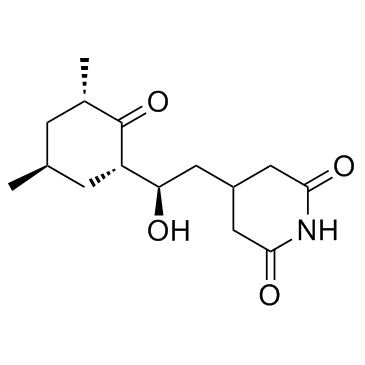Cycloheximide

Cycloheximide structure
|
Common Name | Cycloheximide | ||
|---|---|---|---|---|
| CAS Number | 66-81-9 | Molecular Weight | 281.347 | |
| Density | 1.1±0.1 g/cm3 | Boiling Point | 491.8±10.0 °C at 760 mmHg | |
| Molecular Formula | C15H23NO4 | Melting Point | 111-116 °C | |
| MSDS | Chinese USA | Flash Point | 251.2±19.0 °C | |
| Symbol |



GHS06, GHS08, GHS09 |
Signal Word | Danger | |
|
A survey of the interactome of Kaposi's sarcoma-associated herpesvirus ORF45 revealed its binding to viral ORF33 and cellular USP7, resulting in stabilization of ORF33 that is required for production of progeny viruses.
J. Virol. 89(9) , 4918-31, (2015) The ORF45 protein of Kaposi's sarcoma-associated herpesvirus (KSHV) is a gammaherpesvirus-specific immediate-early tegument protein. Our previous studies have revealed its crucial roles in both early and late stages of KSHV infection. In this study, we survey... |
|
|
Inducible, tightly regulated and growth condition-independent transcription factor in Saccharomyces cerevisiae.
Nucleic Acids Res. 42(17) , e130, (2014) The precise control of gene expression is essential in basic biological research as well as in biotechnological applications. Most regulated systems available in yeast enable only the overexpression of the target gene, excluding the possibility of intermediat... |
|
|
Endoplasmic reticulum stress sensitizes cells to DNA damage-induced apoptosis through p53-dependent suppression of p21(CDKN1A).
Nat. Commun. 5 , 5067, (2014) Endoplasmic reticulum (ER) stress occurs in poorly perfused tissues and activates the p53 isoform p53/47 to promote G2 arrest via 14-3-3σ. This contrasts with the p21(CDKN1A)-dependent G1 arrest caused by p53 following DNA damage. It is not known how cells re... |
|
|
Mutations in MAB21L2 result in ocular Coloboma, microcornea and cataracts.
PLoS Genet. 11(2) , e1005002, (2015) Ocular coloboma results from abnormal embryonic development and is often associated with additional ocular and systemic features. Coloboma is a highly heterogeneous disorder with many cases remaining unexplained. Whole exome sequencing from two cousins affect... |
|
|
Dominant negative effect of polyglutamine expansion perturbs normal function of ataxin-3 in neuronal cells.
Hum. Mol. Genet. 24(1) , 100-17, (2014) The physiological function of Ataxin-3 (ATXN3), a deubiquitylase (DUB) involved in Machado-Joseph Disease (MJD), remains elusive. In this study, we demonstrate that ATXN3 is required for neuronal differentiation and for normal cell morphology, cytoskeletal or... |
|
|
Hypoxia reduces MAX expression in endothelial cells by unproductive splicing.
FEBS Lett. 588(24) , 4784-90, (2014) The MYC-MAX-MXD network is involved in the regulation of cell differentiation and proliferation. Hypoxia affects the expression levels of several members of this network, but changes specific to MAX expression have so far not been shown. We found that in endo... |
|
|
Rad23 interaction with the proteasome is regulated by phosphorylation of its ubiquitin-like (UbL) domain.
J. Mol. Biol. 426(24) , 4049-60, (2014) Rad23 was identified as a DNA repair protein, although a role in protein degradation has been described. The protein degradation function of Rad23 contributes to cell cycle progression, stress response, endoplasmic reticulum proteolysis, and DNA repair. Rad23... |
|
|
Beclin 1 restrains tumorigenesis through Mcl-1 destabilization in an autophagy-independent reciprocal manner.
Nat. Commun. 5 , 5637, (2014) Mcl-1 is a unique Bcl-2 family member that plays crucial roles in apoptosis. Apoptosis-unrelated functions of Mcl-1 are however emerging, further justifying its tight regulation. Here we unravel a novel mechanism of Mcl-1 regulation mediated by the haplo-insu... |
|
|
RIPK1 promotes death receptor-independent caspase-8-mediated apoptosis under unresolved ER stress conditions.
Cell Death Dis. 5 , e1555, (2014) Accumulation of unfolded proteins in the endoplasmic reticulum (ER) causes ER stress and results in the activation of the unfolded protein response (UPR), which aims at restoring ER homeostasis. However, when the stress is too severe the UPR switches from bei... |
|
|
Cytokeratin19 induced by HER2/ERK binds and stabilizes HER2 on cell membranes.
Cell Death Differ. 22(4) , 665-76, (2015) Cytokeratin19 (KRT19) is widely used as a biomarker for the detection of disseminated tumors. Using an LC-MS/MS proteomics approach, we found that KRT19 was upregulated in HER2-overexpressing cells and tissues. KRT19 expression was induced by HER2-downstream ... |